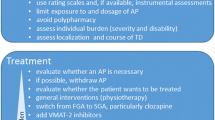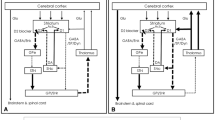Opinion statement
-
Although there are many published studies on the treatment of tardive dyskinesia (TD), relatively few treatments have proven to be consistently useful in clinical practice. Reviewed critically, most treatments have produced only slight to moderate benefit in less than half the patients treated, Class IIIc]. Emphasis instead is on prevention, prompt detection, and management of early and potentially reversible cases.
-
If a patient develops dyskinesia while taking an antipsychotic drug (APD), ideal management is immediate discontinuation of the APD, if this is psychiatrically feasible. The manifestations of TD should be documented and the patient examined to exclude other possible causes of dyskinesia. APDs should then be withheld in the hope that the dyskinesia will disappear. Although the dyskinesia may fade within several weeks, it has the potential to recur if APD treatment is reintroduced. Psychiatric reevaluation to consider alternative psychiatric diagnoses or treatments is strongly advised. If there is no alternative to reintroducing an APD for psychiatric treatment, then an atypical neuroleptic should be considered.
-
Because dyskinesia is very often not disturbing enough to require treatment, the need for treatment of TD should be carefully assessed. For mild dyskinesia, low doses of a benzodiazepine (eg, clonazepam) may reduce the amount of both dyskinesia and associated anxiety. Anticholinergic drugs are unhelpful and may aggravate TD but, similar to their effect in idiopathic dystonia, may be effective in tardive dystonia, Class IIIa2]. Botulinum toxin injections are of considerable value in managing localized forms of tardive dystonia, such as retrocollis or blepharospasm, Class IIIa2]. Tetrabenazine and reserpine are presynaptic dopamine depletors that may have considerable efficacy in TD, especially tardive dystonia, Class IIIc]; however, their use is often limited by side effects. Based on the rationale that TD may be due to formation of free radicals, vitamin E has been used for treatment of TD, with mixed results.
-
In some patients with persistent and disabling TD that fails to remit even after the patient is no longer taking an APD, it may be necessary to resume treatment eventually with a typical APD. This approach should be considered only as a last resort to suppress TD, however, because it carries the risk of preventing remission and possibly aggravating TD. In this case, further attempts to taper and discontinue the APD are recommended.
-
At present, there is no evidence that established TD continues to progress in severity with continued APD exposure, Class IIIa2]. This nonprogressive character of TD may provide to be a consolation to the patient and family and is also of potential medical-legal importance.
Similar content being viewed by others
References and Recommended Reading
Jeste DV, Lohr JB, Clark K, et al.: Pharmacological treatments of tardive dyskinesia in the 1980’s. J Clin Psychopharmacol 1988, 8:38S-48S.
Kang UJ, Burke RE, Fahn S: Natural history and treatment of tardive dystonia. Mov Disord 1986, 1:193–208. This is an excellent review of a single center’s experience with tardive dystonia.
Tarsy D, Kaufman D, Sethi KD, et al.: An open-label study of botulinum toxin A for treatment of tardive dystonia. Clin Neuropharmacol 1997, 20:90–93. This is the first large series of patients with tardive dystonia treated with botulinum toxin.
Jankovic J: Tardive syndromes and other drug-induced movement disorders. Clin Neuropharmacol 1995, 18:197–214. An excellent overview of variants of TD is presented.
Gardos G, Casey DE, Cole JO, et al.: Ten-year outcome of tardive dyskinesia. Am J Psychiatry 1994, 151:836–841.
Tarsy D: History and definition of tardive dyskinesia. Clin Neuropharmacol 1983, 6:91–99.
Schooler NR, Kane JM: Research diagnoses for tardive dyskinesia. Arch Gen Psychiatry 1982, 39:486–487.
Tarsy D: Akathisia. In Movement Disorders in Neurology and Neuropsychiatry, edn 2. Edited by Joseph AB, Young RR. Boston: Blackwell; 1999:75–83.
Tarsy D, Baldessarini RJ: The tardive dyskinesia syndrome. In Clinical Neuropharmacology, vol 1. Edited by Klawans HL. New York: Raven Press; 1976:29–61.
Kane JM, Smith JM: Tardive dyskinesia. Prevalence and risk factors, 1959–1979. Arch Gen Psychiatry 1982, 39:473–481. This is an excellent meta-analysis that established the accepted prevalence figures for tardive dyskinesia and spontaneous dyskinesia.
Kane JM, Woerner M, Weinhold P: Incidence of tardive dyskinesia: five-year data from a prospective study. Psychopharmacol Bull 1984, 20:387–389. This is the first prospective study establishing incidence figures for tardive dyskinesia.
Smith JM, Baldessarini RJ: Changes in prevalence, severity, and recovery in tardive dyskinesia with age. Arch Gen Psychiatry 1980, 37:1368–1373.
Thaker GK, Nguyen JA, Strauss ME, et al.: Clonazepam treatment of tardive dyskinesia: a practical GABAmimetic strategy. Am J Psychiatry 1990, 147:445–451.
Bobruff A, Gardos G, Tarsy D, et al.: Clonazepam and phenobarbital in tardive dyskinesia. Am J Psychiatry 1981, 138:189–193.
Godwin-Austen RB, Clark T: Persistent phenothiazine dyskinesia treated with tetrabenazine. Br Med J 1971, 2:25–26.
Kazamatsuri H, Chien C, Cole JO: Treatment of tardive dyskinesia. Arch Gen Psychiatry 1972, 27:95–99.
Kazamatsuri H, Chien C, Cole JO: Long-term treatment of tardive dyskinesia with haloperidol and tetrabenazine. Am J Psychiatry 1973, 130:479–483.
Jankovic J, Beach J: Long-term effects of tetrabenazine in hyperkinetic movement disorders. Neurology 1997, 48:358–362.
Lang AE, Marsden CD: Alphamethylparatyrosine and tetrabenazine in movement disorders. Clin Neuropharmacol 1982, 5:375–387.
Huang CC, Wang RIH, Hasegawa A, et al.: Reserpine and alpha-methyldopa in the treatment of tardive dyskinesia. Psychopharmacology 1981, 73:359–362.
Sato S, Daly R, Peters H: Reserpine therapy of phenothiazine induced dyskinesia. Dis Nerv Syst 1971, 32:680–684.
Suzuki T, Hori T, Baba A, et al.: Effectiveness of anticholinergics and neuroleptic dose reduction on neuroleptic-induced pleurothotonus (Pisa syndrome). J Clin Psychopharmacol 1999, 19:277–280.
Lieberman JA, Saltz BL, Johns CA, et al.: The effects of clozapine on tardive dyskinesia. Br J Psychiatry 1991, 158:503–510. A thoughtful discussion of the role of clozapine in the management of tardive dyskinesia is presented.
Spivak B, Mester R, Abesgaus J, et al.: Clozapine treatment for neuroleptic-induced tardive dyskinesia, parkinsonism, and chronic akathisia in schizophrenic patients. J Clin Psychiatry 1997, 58:318–322.
Factor SA, Friedman JH: The emerging role of clozapine in the treatment of movement disorders. Mov Disord 1997, 12:483–496.
Fernandez H, Friedman JH: The role of atypical antipsychotics in the treatment of movement disorders. CNS Drugs 1999, 11:467–483. This is an excellent review of the use of atypical neuroleptics in the treatment of movement disorders.
Adler LA, Pesalow E, Rotrosen J, et al.: Vitamin E treatment of tardive dyskinesia. Am J Psychiatry 1993, 150:1405–1407.
Dabiri LM, Pasta D, Darby JK, et al.: Effectiveness of vitamin E for treatment of long-term tardive dyskinesia. Am J Psychiatry 1994, 159:925–926.
Lohr JB, Cadet JL, Lohr MA, et al.: Alpha-tocopherol in tardive dyskinesia. Lancet 1987, 1:913–914.
Eagen MF, Hyde TM, Albers GW, et al.: Treatment of tardive dyskinesia with vitamin E. Am J Psychiatry 1992, 149:773–777.
Shriqui CL, Bradwejn J, Annabel L, et al.: Vitamin E and the treatment of tardive dyskinesia: a doubleblind placebo-controlled study. Am J Psychiatry 1992, 149:391–393.
Dorevitch A, Kallian M, Shlafman M, et al.: Treatment of long-term tardive dyskinesia with vitamin E. Biol Psychiatry 1997, 41:114–116.
Gardos G: Managing antipsychotic-induced tardive dyskinesia. Drug Safety 1999, 20:187–193. An excellent review is presented with a useful algorithm for the management of tardive dyskinesia.
Brashear A, Ambrosius WT, Eckert GJ, et al.: Comparison of tardive dystonia and idiopathic cervical dystonia with botulinum toxin type A. Mov Disord 1998, 13:158–161.
Wang Y, Turnbull I, Calne S, et al.: Pallidotomy for tardive dyskinesia. Lancet 1997, 349:777–778.
Ondo WG, Desaloms JM, Jankovic J, et al.: Pallidotomy for generalized dystonia. Mov Disord 1998, 13:693–698.
Albanese H, Gaarder K: Biofeedback treatment of tardive dyskinesia: two case reports. Am J Psychiatry 1977, 134:1149–1150.
Asnis GM, Leopold MA: A single-blind study of ECT in patients with tardive dyskinesia. Am J Psychiatry 1978, 135:1235–1236.
Task Force on Late Neurological Effects of Antipsychotic Drugs: Tardive dyskinesia: summary of a Task Force Report of the American Psychiatric Association. Am J Psychiatry 1980, 137:1163–1172.
Tardive Dyskinesia: a Task Force Report of the American Psychiatric Association. Washington, DC: American Psychiatry Association Press; 1992. This authoritative review is required reading for physicians who use antipsychotic drugs.
Author information
Authors and Affiliations
Rights and permissions
About this article
Cite this article
Tarsy, D. Tardive dyskinesia. Curr Treat Options Neurol 2, 205–213 (2000). https://doi.org/10.1007/s11940-000-0003-4
Issue Date:
DOI: https://doi.org/10.1007/s11940-000-0003-4




